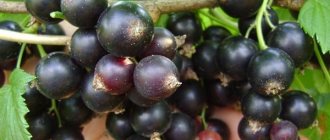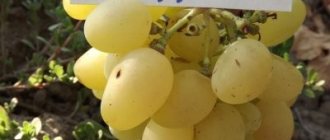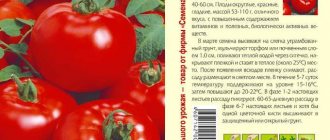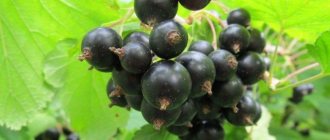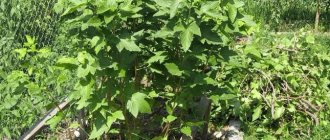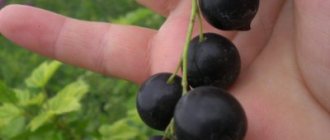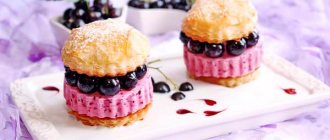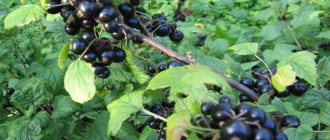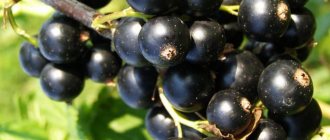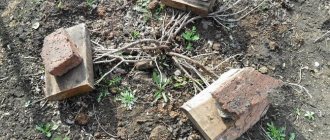Currant variety Selechenskaya 2: reviews on cultivation, planting and caring for the bush
Many gardeners grow different varieties of blackcurrants. The berries of this fruit bush contain a large amount of ascorbic acid, many other vitamins, minerals and a number of active substances.
Therefore, collecting large harvests of these berries is the dream of any summer resident. Currently, there are many varieties of this berry bush, bred not only by foreign, but also by Russian breeders. This article will talk about black currant Selechenskaya 2, bred by specialists from Russia.
The content of the article:
1. History of creation 2. Main characteristics 3. Productivity of the currant variety Selechenskaya No. 2 4. Diseases and pests 5. Advantages of the variety 6. Proper planting of seedlings 7. Further care of currant Selechenskaya 2 8. Feeding currant bushes 9. Pruning 10. Reviews currant Selechenskaya No. 2
History of the variety's creation
The first variety of this berry crop, Selechenskaya, was bred by Bryansk breeder A.I. Astakhov at the end of the last century and entered into the State Register in 1993.
Although Selechenskaya currant had undeniable advantages - early ripening of the crop, good taste of the fruit, this variety also had serious disadvantages:
- increased demands on soil conditions;
- low resistance to major diseases that usually affect this berry crop.
Therefore, Astakhov continued to work on improving the variety together with another breeder L.I. Zueva, which resulted in another new variety, which was given the name Selechenskaya 2. Under this name, in 2004, this currant was entered into the State Register.
Currant Selechenskaya 2 - photo
Both varieties are recommended for cultivation in most Russian regions, Belarus and Ukraine.
Advantages and disadvantages
The variety is very popular both in Russia and abroad. It is characterized by a stable high yield and excellent taste.
The fruits are used fresh; they are suitable for cooking and canning.
pros
- high productivity;
- large berries;
- heat resistance;
- frost resistance;
- pleasant taste;
- rich chemical composition.
Minuses
- high requirements for soil and fertilizers;
- susceptibility to anthracnose and powdery mildew;
- low resistance to return frosts.
Currant Selechenskaya 2: main characteristics and description of the variety
This variety is distinguished by early ripening of fruits, but the harvest ripens gradually, so ripe berries must be collected from the second ten days of July to the first ten days of August.
Since being included in the State Register of Russia, this improved variety has become no less popular than Selechenskaya currant. The bushes are of medium height, quite compact, with a diameter of 1.5-1.6 m.
Shoots are erect, up to 1.8-2.0 m high, well leafy. The foliage is medium in size, three-lobed, dark emerald in color.
Photo of currant Selechenskaya 2
Small purple flowers are collected in racemose inflorescences, each of which can contain from 9 to 14 buds.
The fruits are round in shape, black in color, weighing about 5 g. The taste is pleasant, rich, with a characteristic smell of currants, no astringency.
100 g of berry products contains:
- 7.3% sugars;
- 160 mg ascorbic acid.
Currant Selechenskaya 2 – video
Tasting assessment of ripe Selechenskaya currant berries – 4.8 points
, their separation from the stalks is dry. Ripe fruits are not prone to shedding; they can hang on the bushes for a long time after ripening. The collected berries can be consumed fresh, made into jam, closed into compotes, or frozen for the winter. Also, many housewives grind ripe berries with sugar and store them in the refrigerator - ascorbic acid is better preserved in such preparations.
The harvested crop can withstand transportation well over long distances, without losing its taste and presentation.
On a note!
The Selechenskaya variety is highly resistant to frost, but approximately half of the blooming flowers may freeze during the period of return spring frosts.
The bushes are distinguished by their unpretentiousness to the composition and fertility of the soil; they can grow and bear fruit in partial shade or next to tall fruit trees
Characteristics of culture
The currant variety has features that make it popular among gardeners regardless of climatic conditions.
Resistance to frost and drought
The crop blooms in mid-May and is resistant to morning frosts. This variety of shrubs is resistant to heat, however, at high temperatures and lack of timely watering, the berries may fall off before they ripen.
What diseases and insects is the variety susceptible to?
Berries, like other types of plants, are damaged by pests and diseases that reduce productivity.
The following types of pests often appear:
- Biennial leaf roller. The insect attacks the buds of the plant. It multiplies quickly and can lead to the death of inflorescences in a short time. To eliminate the pest, drugs such as Actellik are used. Treatment with the substance must be carried out in May.
- Currant glasswort - insects infect the plant under the bark and lead to the death of the bush. For treatment, the drug “Revicut” is used, which is sprayed immediately after the thaw before the buds begin to bloom.
- Aphids - appear on young shoots and cause branches to dry out. To eliminate the pest, a solution of laundry soap is used.
- The fruit sawfly is a pest that manifests itself as larvae that hatch directly in the inflorescence and, after the berries ripen, damage the currants and contribute to the appearance of rot. To prevent this, “Etafos” is used; the substance is sprayed when inflorescences appear.
Among the diseases it is necessary to highlight:
- Doubleness of flowers - manifests itself in the form of changes in inflorescences and asexuality of flowers. Plants cannot be treated and require complete removal.
- Rust - characterized by brown and brown spots on the leaves. When damaged, the bush dries out. Eliminated with boric acid solution.
- Rot - can manifest itself both in the root area and in the clusters of berries. To eliminate it, it is recommended to use copper sulfate.
With proper care, the currant variety develops immunity that copes with a large number of diseases.
Productivity of currant variety Selechenskaya No. 2
The first harvest from Selechenskaya currant bushes is harvested in the second or third season after planting.
If the seedlings are planted in the fall, and flowers appear on them in the spring, it is better to remove them - in the first season, the bushes should only actively increase the vegetative mass. Their roots should also grow and develop.
Currant varieties!
Lazy Yadrenaya Dobrynya
The fruiting of the variety is extended over time, the berries on the bushes ripen gradually, in general, from 2.5 to 4.5 kg of ripe fruits are collected from one Selechenskaya 2 currant bush.
Reproduction methods
Propagation of Selechenskaya currant is carried out by offshoots or woody and green cuttings. In the first case, they dig a hole near the bush, tilt the shoot towards it and cover it with earth, strengthening it with a spacer. With regular moistening, the branches will quickly take root and can be replanted. In the second case, cuttings 20 cm long and 10 mm in diameter are cut from the bush, treated with paraffin, wrapped in damp paper and put in the refrigerator. In spring they are planted in the ground. You can also keep the cuttings in a growth stimulator, plant them in containers with fertile soil, cover them with film and wait for them to take root.
Advantages of the variety
The main advantages of the Selechenskaya 2 currant variety include:
- large fruit size;
- the Selechenskaya 2 variety has a fairly high yield;
- undemanding to growing conditions and further care;
- high resistance of bushes to fungal diseases;
- good taste of ripe fruits;
- the harvested crop tolerates transportation well;
- berries are distinguished by their versatility of use.
Advantages and disadvantages of the variety
Positive qualities include the following characteristics. They include:
- Large and juicy berries;
- Good harvest;
- Frost resistance;
- Easy to care for.
The disadvantages of Selechenskaya currant include the following points;
- Needs regular watering;
- Not able to resist anthracnose;
- Before planting, it is necessary to take into account the plant’s preferences for the composition of the soil substrate;
- Staying in one place for a long time leads to crushing of the berries.
Currant Selechenskaya 2: proper planting of seedlings
You should start by choosing seedlings of this currant variety:
- For planting, purchase only one-year or two-year-old plants with a healthy root system, without visible signs of damage to shoots and roots;
- the height of the shoots should be no more than 40 cm, their radius at the base should be 4-5 mm, their bark should be smooth, the foliage should have no signs of wilting;
- the root system is well branched, with several skeletal branches up to 17-20 cm long, without signs of drying out;
- For seedlings planted in spring, the buds should swell.
Plants can be planted in light partial shade, the main thing is that the seedlings are protected from gusts of cold wind. You can plant them in one row along a fence or blank walls of a garden house or other buildings.
The pH of the area should be slightly alkaline or neutral. The occurrence of groundwater should be deeper than 1.1 m from the soil surface.
Selechenskaya currants can be planted both in spring and autumn. When planting in spring, the site is prepared in the fall. Before digging, humus is added to it at the rate of 6-7 kg of fertilizer per square. In the spring, mineral fertilizers are added to the planting holes: potassium sulfate, wood ash and superphosphate. Dolomite flour or lime should be added to acidified soil in the fall.
Advice!
When planting Selechenskaya currant seedlings in the fall, the site needs to be prepared approximately 80-90 days before this procedure.
The distance between planting holes should be at least 1.8-2.0 m.
The cuttings are placed in the hole at an acute angle. This is also done when planting a seedling in heavy soil.
The holes are filled with nutrient substrate and compacted. The root collar should be buried 5-6 cm into the soil. A high enough side is made along the edge of the tree trunk circle so that water does not go beyond its limits when watering. After planting, pour at least 2 buckets of water under each plant.
Interesting!
How to get rid of wireworm
Care
The variety is demanding when it comes to agrotechnical practices. In order for Selechenskaya blackcurrant to produce annual harvests, you need to apply standard care rules, the same as for other varieties, with the exception of some nuances.
Recent Entries
5 working ways to use tar in the garden 7 indoor plants that help you get married even in adulthood Indoor plants that can bloom in trouble
Watering
Like most varieties of black currant, Selechenskaya loves moderately moist soil. This state can be achieved only by timely, abundant watering. But at the same time, it should be remembered that overwatering will not turn out to be anything good.
When creating a watering schedule, be sure to take into account precipitation.
Mandatory watering is carried out during the following periods:
- shoot growth and ovary formation;
- during the period of berry filling;
- after harvest;
- pre-winter, if autumn is stingy with precipitation.
Insufficient watering will lead to stunted shoot growth, shredding of fruits and loss of taste. For high-quality hydration, water must penetrate the soil to a depth of at least 40 cm. You will have to use up to 5 buckets for one bush. To prevent moisture from spreading over the surface, ring grooves should be made around the bush at a distance of 30–40 cm from the end of the branches (10 cm deep).
To water currants you need to make circular grooves
The next day after watering or rain, you need to lightly loosen the soil cover. This simple procedure will bring a lot of benefits. By destroying the formed crust, you help to establish air-water circulation in the soil, which has a beneficial effect on the development of the plant. In addition, loosening inhibits the growth of weeds.
Don't forget to mulch the ground under the bush. Dry grass or humus will not only serve as additional nutrition, but will also help retain moisture in the soil.
To avoid moisture loss, mulch the currant bush after watering.
Feeding
After planting, provided that the necessary substances are added to the planting hole, the currants are not fertilized for 2 years. At this time, you can use organic matter as mulch, adding a bucket of humus or manure under each bush in spring and autumn.
Starting from the 3rd year after planting, beneficial substances are applied three times during the season. Selechenskaya responds equally well to organic matter and mineral fertilizers. Each type of fertilizing has its own period and method of application.
- In early spring, in order for the plant to wake up and quickly begin to grow, up to 45 g of urea is added under shallow digging for a young bush and 25–30 g for an adult one. After this, the ground is watered and mulched with organic matter.
- In summer, after moistening, it is very useful to water the ground under the bush with a solution of chicken droppings (diluted with water in a ratio of 1:10). 10 liters of mixture is enough for one plant.
- Autumn feeding contains potassium sulfate (15–20 g) and superphosphate (40–50 g). Instead of mineral fertilizers, you can use wood ash (200–400 g). Fertilizers are embedded in the ground 10–15 cm deep, after which the soil around the bush is covered with humus or manure (6–7 kg).
Trimming
The first 4 years from the moment of planting Selechenskaya are extremely important in terms of the formation of the bush and maintaining its productivity.
- In the spring, before the buds open, the shoots of a young seedling are cut to half their length or even 2/3.
- In the 2nd year, the base of the bush is formed, that is, 4–5 strong shoots are laid. The rest are deleted. To help the seedling grow young fruit branches and new shoots, the tops of the skeletal branches are pinched in mid-summer.
- In the 3rd and 4th years the procedure is repeated. Last year's branches are pinched into 2 buds. Of the growing young shoots, 3–5 of the strongest ones are left, the rest are cut out.
- In the 5th year, the formation of the bush is considered complete if it has at least 4 main shoots of each age.
Formative pruning of Selechenskaya is carried out in the first 4 years after planting
All branches older than 6 years are cut close to the ground. This is necessary to rejuvenate the bush. In the future, you need to thin out the plant, removing weak, crooked shoots that have virtually no fruit buds.
When carrying out thinning pruning, you need to leave no more than 4 strong shoots of zero age. The distance between them should be at least 10–15 cm.
Shelter for the winter
Black currant Selechenskaya is a frost-resistant crop. Strong and healthy plants can withstand frosts below -300C, so they do not need additional shelter. But some measures need to be taken.
- Be sure to carry out a set of preparatory measures before the start of winter: remove leaves, apply fertilizers, dig up the soil, water (if autumn is dry).
- The branches of the bushes are tied together so that they are not broken by strong gusts of wind.
- The root area is covered with a layer of mulch (manure, humus, peat, sawdust).
- After snow falls, a snowdrift is poured into the root area. This natural protection perfectly protects currants from frost.
Young seedlings or weakened plants need additional protection. Before the onset of frost, the bushes are wrapped in breathable non-woven material.
For Selechenskaya seedlings you need to make a shelter before the onset of frost
Video: caring for black currants
Further care for Selechenskaya 2 currants
This variety of currant requires regular watering at the time of flowering, ovary formation, and fruit formation.
Watering is carried out every 3-4 days, adding 10 to 30 liters of water to each bush, depending on weather conditions.
Advice!
It is imperative to carry out moisture-recharging irrigation when preparing currants for winter - in the last ten days of September - the first ten days of October.
After watering, it is imperative to loosen the tree trunk circles, while simultaneously removing weeds.
Before the onset of frost, young bushes are covered so that the plants do not freeze out during severe frosts.
Feeding Selechenskaya currant bushes
The main stages of fertilizing Selechenskaya currants:
- In the spring and autumn, a solution of cow manure diluted in a concentration of 1:4 is introduced into the tree trunk circles. But you can replace it with diluted chicken manure - 100 g of fertilizer is diluted in a bucket of water.
- Three seasons after planting, urea (up to 30 g) should be added to the Selechenskaya 2 currant fertilizer in the spring. Compost or humus is used as mulch after watering.
- In the fall, after moisture-recharging irrigation, 2 tbsp are added to each currant bush. l. superphosphate and 1.5 tbsp. l. potassium sulfate.
- If the soil in the garden plot is fertile, then in the fall mineral fertilizers are replaced with wood ash (2 cups of fertilizer per 1 m2).
Currant feeding
How to plant
As you can see, this variety is very good - productive, quite resistant to diseases and not particularly whimsical. How to plant Selechenskaya currant correctly? This procedure is not particularly complicated. Its bushes are planted in the same way as any other early varieties of currants. The same goes for caring for plants.
It is best to plant in late autumn or spring, before the buds open. Selechenskaya currant is absolutely undemanding when it comes to soil. However, by choosing a good place for planting and properly preparing the soil, you can get much more abundant harvests. As for Selechenskaya-2, for this currant, preliminary soil improvement is a mandatory procedure.
Selechenskaya black currant is planted in a well-lit, non-flooded area. Dig holes 50 cm deep across the garden in a direction from north to south at a distance of 1.5-2 meters from each other according to the number of bushes.
Place a seedling in each hole at an angle of 45 degrees, with the roots facing south, so that the neck is 15 cm below ground level. Fill the holes with the improved soil prepared in advance and lightly compact the tree trunk circle. Soil for currants is prepared as follows: good garden soil is mixed with humus and 100 g of nitroammophoska and a glass of ash are added to a bucket of the mixture. Currants take nutrients from a depth of about 40 cm. Therefore, the resulting fertile layer for the bush will be quite enough. The diameter of the holes, however, should not be less than 60 cm. Otherwise, Selechenskaya black currant will still experience a lack of nutrients.
After planting, the tree trunk circles should be mulched. The seedlings themselves are pruned so that 3-4 buds remain above the soil surface. In addition, you need to pour about a bucket of water onto each bush.
Currant Selechenskaya: pruning
Formative pruning of Selechenskaya currant bushes is carried out in spring or autumn.
It must be remembered that the harvest is laid on 2-3 year old shoots.
Every year up to 15-20 new shoots appear on the bushes, which are not touched until spring.
In the next season, no more than 6 of last year's strongest shoots are left, the rest are cut out.
In summer, the tops of the branches are pinched to stimulate the growth of side shoots.
Before the onset of cold weather, the stems are cut off, leaving no more than 5 eyes on each.
In the fall, during pruning, old branches that are more than 5 years old are removed, because they will no longer produce a crop. Damaged and dried branches are also removed.
Currant pruning
Preparing the site
Sechelinskaya black currant prefers well-lit areas. Experienced gardeners recommend avoiding places with through air movement.
You should not plant the crop next to a metal fence. In summer, the surface becomes very hot, thereby leading to burns on the delicate leaves of the plant.
Currant Selechenskaya 2: reviews from those who grow the variety
Nina, 65, Zlatoust: At first we grew Selechenskaya currants in the garden. But it was demanding on the composition of the soil and was severely affected by fungal diseases. Several seasons ago I replaced this variety with Selechenskaya 2 and noted that this currant has larger berries, can bear fruit in the shade, and the taste of the berries does not become worse.
Luda, 45 years old, Toropets: Both varieties of this currant grow in my garden. I don’t feel any difference in caring for them, only Selechenskaya 2 has a larger fruit size. Both varieties can be affected by aphids if preventive plant treatments are not carried out.
Grigory, 60 years old, village. Korkino: This currant variety has been growing in my garden for 10 years. I would like to note that its fruits are very tasty, the bushes are frost-resistant, and the yield is not bad.
Despite the fact that the Selechenskaya 2 currant variety was developed relatively recently, it has already become popular among gardeners from different Russian regions, as it is resistant to frost and fungal diseases, larger berry size and good taste of ripe fruits.
Diseases and pests
The black currant varieties Selechenskaya and Selechenskaya 2 are resistant to pests and diseases, but with irregular care they are sometimes affected by them. The varieties have high immunity to bud mites and powdery mildew. To prevent diseases, you should follow the rules of care and spray the bushes with special products. During chemical treatment, drugs are used strictly according to the instructions. Treatment with insecticides and fungicides is carried out in dry, windless weather.
Prevention and pest control - table
| Pest | Description and nature of the lesion | Processing period | Control measures | Prevention |
| Biennial leaf roller | The butterfly is 13–16 mm yellow-pink in color with a brown stripe. Caterpillars overwinter in bark cracks, fallen leaves and in spider cocoons. Nature of the lesion: the larvae eat the buds from the inside. Signs: buds dry out and change color. | May. | Preparations Actellik, Antio according to the instructions. |
|
| Currant glass | A butterfly with a wingspan of 20 mm. The body is covered with lilac-black scales. Nature of the lesion: the larvae develop under the bark, the caterpillars gnaw out the core of the branches. Signs: at the end of flowering, the branches wither or dry out completely. | Before the buds open. | Preparations Rovikurt, Karbofos according to the instructions. | Compliance with the dosage of fertilizing. |
| Leaf gall aphid | Small insects 22 mm long. Lays larvae on the bark near the buds. Nature of the lesion: the larvae feed on plant sap. Signs of damage: leaves and tops of branches curl and dry out. | Before the buds open. | Preparations Sumicidin, Actellik according to the instructions. | In early spring, treat the bushes with a 3% urea solution. |
| Spider mite | Brown insect, length 0.4 mm. Located at the bottom of the sheet. Nature of the attack: feeds on plant sap. Signs of damage: light spots and discolored areas appear on the leaves. With severe damage, the leaf becomes marbled. | Before the buds open. | Vofatox according to instructions. |
|
| On the eve of flowering. | Treatment of bushes with colloidal sulfur. | |||
| Currant gall midge | Small mosquito 3 mm long. Nature of the lesion: the larvae develop under the bark and feed on shoots. Signs of damage: dark depressed spots and cracks appear on the damaged areas. The branches dry out and break. | Budding period. | Preparations Karbofos, Rovikurt according to the instructions. |
|
| Blackcurrant fruit sawfly | The insect is yellow in color with transparent wings, about 4 mm long. Nature of the lesion: females lay eggs in large currant ovaries. During development, the larvae gnaw out the seeds of the fruit. Signs of damage: damaged berries grow, become ribbed and seem to ripen ahead of time. | In July. | The affected berries are picked by hand. |
|
| After flowering. | Preparations Etafos, Ambush according to the instructions. |
Currant pests in the photo
The blackcurrant sawfly is the most common dangerous pest of currants.
Regular inspection of bushes helps reduce the population of currant glass in the garden
Currant shoot gall midge is usually found in dense plantings when bushes are grown in shaded, damp places
Plants affected by spider mites have a greatly reduced yield and winter hardiness.
Leaf gall aphids cause cherry-red growths to form on leaves.
One biennial leaf roller caterpillar can damage up to 30 buds
Disease control and prevention measures - table
| Disease | Description and nature of the lesion | Processing period | Control measures | Prevention |
| Terry (reversion) | Viral disease. Signs: barren flowers of unnatural shape appear. The petals stretch out, acquire a lilac color and become terry. The leaves become three-fingered and acquire a dark green hue. The characteristic smell of black currant disappears. | During the growing season. | Affected bushes are uprooted and burned. |
|
| Columnar rust | Fungal disease. Yellow spots appear on the top of the leaf plate; orange growths with yellow hairs form below in these places. | During bud break. | Bordeaux mixture 1% or Nitrafen according to the instructions. |
|
| Gray rot | This fungus causes brown leaf spot. Signs of damage: the appearance of brown spots on the leaf plate. In the brush you can see damaged berries with a gray coating. | Before flowering. | Treatment of plants and soil with copper sulfate. |
|
| Anthracosis | Fungal disease. Signs of damage: the bark loses its elasticity and cracks. Small bumps appear in the cracks. The branches are drying up. |
| Preparations Cuprozan and Fthalan according to the instructions. |
|
| Yellow vein mosaic | Viral disease. In June, the leaves appear with a bright yellow pattern around the veins. | Early spring. | Treatment of bushes with 1% Bordeaux mixture. |
|
| Summer. | If an affected plant is identified, the bush is uprooted and burned. | |||
| Drying of shoots | Fungal disease. Signs of damage: the bark loses its elasticity and cracks. Small bumps appear in the cracks. The branches are drying up. | Summer. | Pruning damaged shoots. |
|
Currant diseases in the photo
Drying of shoots is a consequence of damage to plants weakened by drought, frost, mechanical damage to shoots, or one of the specific fungal diseases
When columnar rust develops by autumn, the lower part of the leaves becomes covered with brown felt.
Gray rot causes brown leaf spots
With strong development of doubleness, the flower brush turns into a thin twig with scales instead of flowers
Yellow vein mosaic is a viral disease, upon detection of which infected plants must be uprooted and burned
Anthracosis develops strongly in rainy seasons by mid-summer
